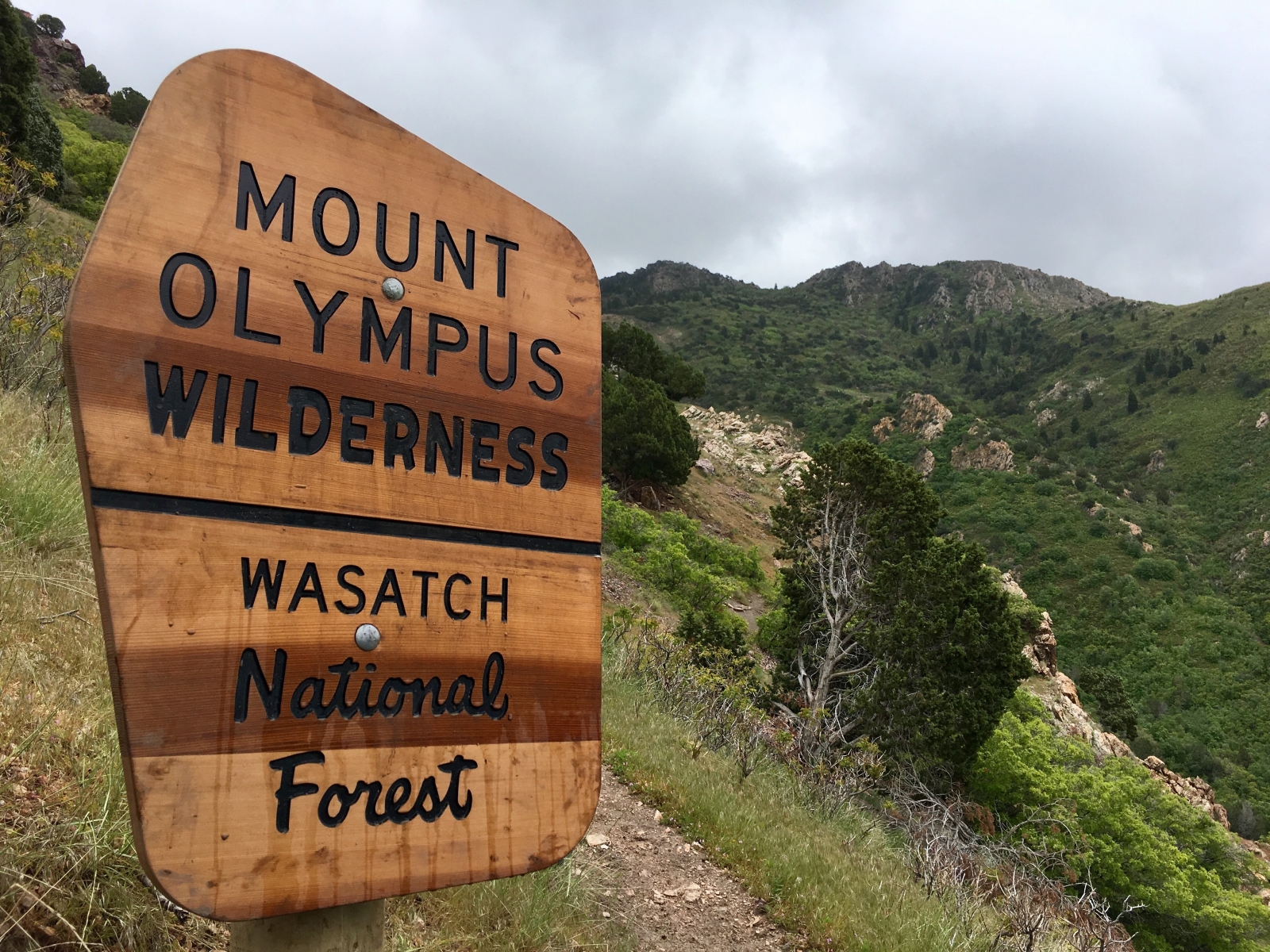There are a wide variety of activities that users can partake in while in Mount Olympus Wilderness. These activities include hiking, trail running, camping, fishing, backcountry skiing and snowboarding and rock climbing. Users should remember that activities have special regulations due to their location in a wilderness and a partial watershed area, which means some activities are prohibited. It is important to follow the Leave No Trace Seven Principles because they will help users tread lightly and properly and will help to preserve the wilderness for all to enjoy. Mountain biking is prohibited in wilderness and swimming in parts that fall in the watershed. Biking is prohibited because it is a mechanical vehicle, which is not allowed in wilderness areas. Biking is also banned in these areas because it can diminish the quality of solitude that users are seeking. This type of transportation allows for users to travel faster than hikers, which increases human encounters, which as a result lessens the feeling of solitude. Swimming is prohibited on the Big Cottonwood side of the wilderness area due to it being part of the Salt Lake City Watershed. Swimming is banned in watershed areas because humans or dogs swimming in bodies of water that fall within watershed boundaries will contaminate the water and diminish the water quality.
Below is each activity and how to do it properly in a wilderness and decrease your impact:
Hiking/running:
While hiking in wilderness areas there are certain rules to abide by so that the resource is protected. Do not cut switchbacks while hiking because this will leave a visible scar on the landscape and will degrade the feeling of solitude. That area will require restoration so it can go back to what it once was. Stay on trail and do not use user made trails. User made trails can increase the spread of invasive species in an area, can cause hikers to become lost, and can also kill vegetation that could be unique to the area or endangered. Properly dispose of human fecal matter by either packing it out in WAG bags or by digging a 6-8 inch deep hole at least 200 feet from a trail or water source. Popular hiking trails in Mount Olympus Wilderness are the Mount Olympus Trail, Grandeur Peak, Neffs Canyon Trail, Desolation Trail and Butler Fork Loop.
For more information about hiking/running in wilderness areas:
https://www.fs.usda.gov/detail/uwcnf/learning/safety-ethics/?cid=FSEM_035476
Trail information:
https://www.hikingproject.com/directory/8015886/mount-olympus-wilderness-area
Camping:
Camp on durable surfaces or use existing camping sites so that new sites are not made. If you do not have a camp stove, fires are allowed in most areas. When having a campfire use existing fire rings, make sure fire is completely extinguished and spread ashes in wooded areas afterwards. Do not put trash in fire, but backpack it out instead. It is important to leave dead wood instead of burning it because it provides homes to certain native animals, and its decomposition improves soil quality and is a component of the ecosystem. Properly dispose of human fecal matter by either packing it out in WAG bags or by digging a 6-8 inch deep hole at least 200 feet from a trail or water source. Do not wash dishes in a body of water and if need be, do it at least 200 feet from any body of water.
For more information about camping in Wilderness Areas:
https://www.fs.usda.gov/detail/uwcnf/learning/safety-ethics/?cid=FSEM_035476
Fishing:
Fishing in National Forests requires a state fishing license. While fishing in the Wasatch Mountain, it is required to wear waders because of it being a watershed for Salt Lake City. Wash waders before going into new sources of water to stop the spread of new species into an area. Do not transport parts of fish into other bodies of water. Properly dispose of human fecal matter by either packing it out in WAG bags or by digging a 6-8 inch deep hole at least 200 feet from a trail or water source.
For more information about camping in Wilderness Areas:
https://www.fs.usda.gov/detail/uwcnf/learning/safety-ethics/?cid=FSEM_035476
Skiing/Snowboarding:
Skiing and snowboarding are allowed in wilderness areas. To access these backcountry wilderness ski spots you must get there by foot, which means snowshoeing or skinning into the area. Accessing the area by snowmobile or any motorized vehicle is prohibited. The sounds, tracks and sighting of motorized vehicles diminishes the sense of solitude, and disturbs wildlife. Heli skiing is also prohibited in Wilderness Areas because the landing of any aircraft is prohibited. Properly dispose of human fecal matter by either packing it out in WAG bags or by digging a 6-8 inch deep hole at least 200 feet from a trail or water source. Popular backcountry areas for users are the Apollo Chutes, White Fir Pass, Circle All (Circle Awl) Peak and Main Porter to 6500’ . Go to Wasatch Backcountry Map to find more locations.
For more about backcountry skiing/snowboarding ethics:
https://www.wildsnow.com/2012/backcountry-skier-code-ethics/
Rock Climbing:
Rock climbing is allowed in wilderness areas, but there are some points to remember when climbing in these areas. Bolts cannot be changed with a power drill, but must be changed hand drills. Remember to pack out everything that is brought into the area. Properly dispose of human fecal matter by either packing it out in WAG bags or by digging a 6-8 inch deep hole at least 200 feet from a trail or water source. Place climbing pads and gear on durable surfaces. Remember to clean up chalk and tick marks. Also try and minimize your group size and noise.
For more about climbing ethics:
https://www.accessfund.org/learn/the-climbers-pact
Salt Lake Climbers Alliance:
https://www.saltlakeclimbers.org
Contacts:
Salt Lake Ranger District
6944 SOUTH 3000 EAST
SALT LAKE CITY, UT, 84121
Phone: 801-733-2660


